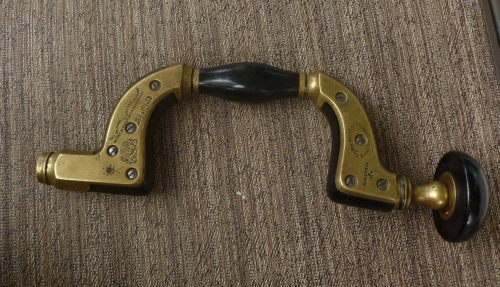 The brace in the picture is an ebony stuffed William Marples Ultimatum brace from between 1875 and 1876. Thanks to Reg Eaton's "The Ultimate Brace" book we can date the brace because this brace has both the "Hibernia" trademark (post 1875) and the missing "I" in William stamp ('pre-1876). The brace in the picture is an ebony stuffed William Marples Ultimatum brace from between 1875 and 1876. Thanks to Reg Eaton's "The Ultimate Brace" book we can date the brace because this brace has both the "Hibernia" trademark (post 1875) and the missing "I" in William stamp ('pre-1876).
William Marples didn't invent the Ultimatum form of brace, that honor belongs to John Cartwright who received a patent in 1848 and then sold the rights to Marples who coined the "Ultimatum" name and became the largest seller of these types of brace by far. After the patent ran out many other makers made similar braces including the Joseph Marples Ltd. (no relation), the folks who currently make most of our gauges (but no braces). William Marples is the same company that eventually merged with Record, which was bought by Rubbermaid, and then in a notably successful effort to reduce quality, moved everything to China about 10 years ago.
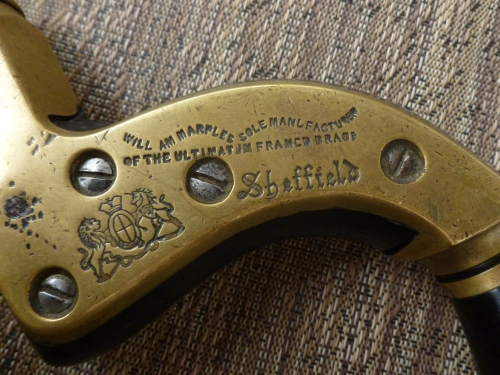 In use Ultimatum braces suck when compared to an American ratcheting brace, and they were considerably more expensive than an all iron Scotch brace or a Spofford brace but the design pre-dates the American brace and Marples made them by the thousands in all grades of quality. Production of the Ultimatum brace seems to have petered out around 1900. In use Ultimatum braces suck when compared to an American ratcheting brace, and they were considerably more expensive than an all iron Scotch brace or a Spofford brace but the design pre-dates the American brace and Marples made them by the thousands in all grades of quality. Production of the Ultimatum brace seems to have petered out around 1900.
This brace, while well worn, is a joy to behold. Ebony, Bronze, how can you go wrong? The head is inlaid with horn, and the end stamp shows a lot of wear. What I really want you to take a look at is the overabundance of maker's marks. They must have used a giant stamp to deeply stamp "William Marples" and by 1875 the second "I" in William was missing and a leg of the second to last "R" has broken off. But what's really wild is that someone cared enough to make this luxurious Victorian stamp, which being so big is no small feat to make, and you need a big press to stamp it deep in the bronze, but they forgot to check if there was space on the brace for it. I know these days we would agonize of shaping the stamp to go AROUND the screw hole, not through.
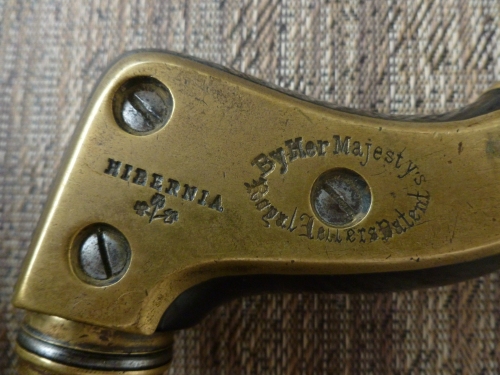 Even Her Majesty, Queen Victoria, wasn't spared and the two "t"s in letters are cut off. Even Her Majesty, Queen Victoria, wasn't spared and the two "t"s in letters are cut off.
Look how elegantly the wood infill is blended with the bronze casting. At some point this brace was owned by an insecure chap named "G. Payne" who stamped his name (poorly) on every blank space he could find. But the real puzzle to me is what is probably an owner's stamp, but might be a retail store stamp that isn't a stamp but is a nicely done engraving.
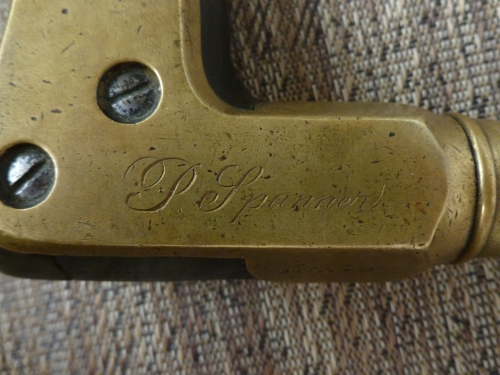 P. Spanner" was probably the original owner of the brace and that the name is engraved in, not stamped, suggests two things: The brace might have been a gift or a presentation to him, or the tool represented such a large purchase that he felt he should trumpet his ownership. I didn't find any company with that name (didn't look very hard either) and I don't know any company that would engrave rather than stamp, so I don't think it's a store mark. P. Spanner" was probably the original owner of the brace and that the name is engraved in, not stamped, suggests two things: The brace might have been a gift or a presentation to him, or the tool represented such a large purchase that he felt he should trumpet his ownership. I didn't find any company with that name (didn't look very hard either) and I don't know any company that would engrave rather than stamp, so I don't think it's a store mark.
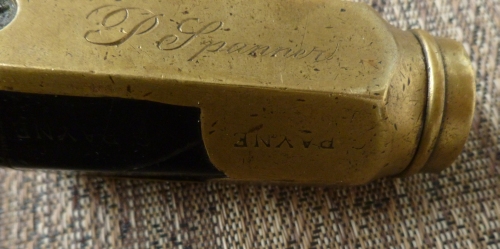 In any event for anyone who has the urge to leave their mark on their tools, you are in good company but I warn you - the standard for engraving is pretty high! In any event for anyone who has the urge to leave their mark on their tools, you are in good company but I warn you - the standard for engraving is pretty high!
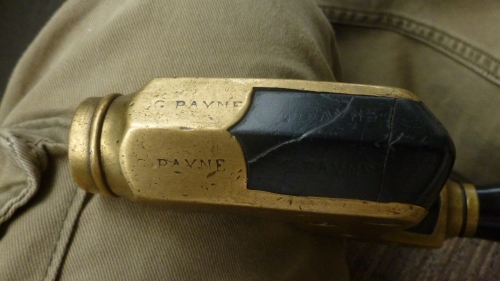 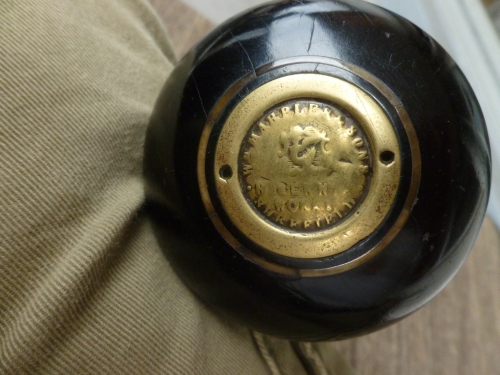
|
 Joel's Blog
Joel's Blog Built-It Blog
Built-It Blog Video Roundup
Video Roundup Classes & Events
Classes & Events Work Magazine
Work Magazine


 The brace in the picture is an ebony stuffed William Marples Ultimatum brace from between 1875 and 1876. Thanks to Reg Eaton's "The Ultimate Brace" book we can date the brace because this brace has both the "Hibernia" trademark (post 1875) and the missing "I" in William stamp ('pre-1876).
The brace in the picture is an ebony stuffed William Marples Ultimatum brace from between 1875 and 1876. Thanks to Reg Eaton's "The Ultimate Brace" book we can date the brace because this brace has both the "Hibernia" trademark (post 1875) and the missing "I" in William stamp ('pre-1876).  In use Ultimatum braces suck when compared to an American ratcheting brace, and they were considerably more expensive than an all iron Scotch brace or a Spofford brace but the design pre-dates the American brace and Marples made them by the thousands in all grades of quality. Production of the Ultimatum brace seems to have petered out around 1900.
In use Ultimatum braces suck when compared to an American ratcheting brace, and they were considerably more expensive than an all iron Scotch brace or a Spofford brace but the design pre-dates the American brace and Marples made them by the thousands in all grades of quality. Production of the Ultimatum brace seems to have petered out around 1900.  Even Her Majesty, Queen Victoria, wasn't spared and the two "t"s in letters are cut off.
Even Her Majesty, Queen Victoria, wasn't spared and the two "t"s in letters are cut off.  P. Spanner" was probably the original owner of the brace and that the name is engraved in, not stamped, suggests two things: The brace might have been a gift or a presentation to him, or the tool represented such a large purchase that he felt he should trumpet his ownership. I didn't find any company with that name (didn't look very hard either) and I don't know any company that would engrave rather than stamp, so I don't think it's a store mark.
P. Spanner" was probably the original owner of the brace and that the name is engraved in, not stamped, suggests two things: The brace might have been a gift or a presentation to him, or the tool represented such a large purchase that he felt he should trumpet his ownership. I didn't find any company with that name (didn't look very hard either) and I don't know any company that would engrave rather than stamp, so I don't think it's a store mark. In any event for anyone who has the urge to leave their mark on their tools, you are in good company but I warn you - the standard for engraving is pretty high!
In any event for anyone who has the urge to leave their mark on their tools, you are in good company but I warn you - the standard for engraving is pretty high!

Yes of course, I wrote about that in my book many years ago. But what I have never seen before - is a hand engraved owner's mark.
joel
Engraving could make sense when a single use stamp would create more labor than saving, so marked by someone besides "P. Spanner" (who should have had his own stamp.)
While I've always thought this was a beautiful form, this post makes it look all NASCAR with it's abundance of marks.